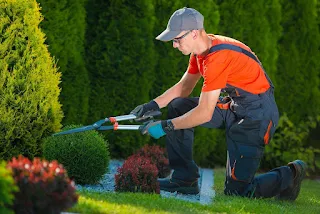A kitchen garden is a
great way to grow fresh produce for wholesome and delectable meals. It doesn't
have to be right outside your kitchen door, but being close by makes it more
convenient and increases the likelihood that you will use the garden often. For
example, if you need chopped dill for your boiled red-skinned potatoes, a
kitchen garden will have it available in a matter of steps.
 |
| Kitchen Gardening |
Starting
a Kitchen Garden: A Comprehensive GuideBy following these simple steps you can make your own kitchen garden in the backyard of your home.
- Selecting
the Garden Site
- Preparing
the Garden Site
- Choosing
Garden Crops
- Planning
and Planting
- Mulching
- Watering
- Garden
Maintenance
- Succession
Planting
Selecting
the Garden Site
 |
| Select a Suitable Place For Your Kitchen Garden |
When deciding where to
put your kitchen garden, a sunny area should precede a nearby one.
The perfect location includes well-draining soil and at least six hours of daily direct sunlight. To ensure adequate drainage, see if puddles vanish a few hours after a rainfall.
After determining the sunniest location, list your objectives for the kitchen
garden. Start small in the first year to ensure success and gradually expand
your garden. Even with a small start, a well-planned garden may
greatly contribute to your family’s produce needs.
Preparing
the Garden Site
 |
| Prepare Your Kitchen Garden Site |
If you’re converting a
lawn into a garden, you can either build raised beds or plant directly in the
ground. Raised beds are beneficial if your soil quality is poor or doesn’t
drain well, and they can be aesthetically pleasing if made from materials like
wood, stone, or corrugated metal. However, they are initially more expensive and labour-intensive. For planting directly in the ground, you’ll need to
remove the sod. This can be done manually with a sharp spade for small areas,
or with a sod cutter for larger areas. Removing and composting the sod ensures
you won’t have grass and weeds growing in your garden.
Choosing
Garden Crops
 |
| Choose Your Garden Crops |
A straightforward and
satisfying option is a salad garden, as lettuces and greens grow quickly and
require little space and maintenance. A “cut-and-come-again” salad mix can
yield multiple harvests. Culinary herbs like parsley, chives, sage, basil,
tarragon, mint, rosemary, and thyme are excellent additions and enhance the
flavour of your meals. Starting with what you like to eat seems obvious, but
it's crucial to avoid disappointment. Experiment with one or two new crops each
year for diversity.
Planning
and Planting
 |
| Sketch And Plan Your Kitchen Garden |
Sketch out a garden
plan detailing what to plant, where, when, and how. Familiarize yourself with
the needs of different crops in terms of space, water, soil fertility, and
temperature. The interactive Vegetable Garden Planner from KGI can simplify
this process. Decide whether to start plants from seeds or transplants. While
starting from seed is cost-effective and satisfying, buying seedlings can
increase your chances of success, especially for crops requiring a long growing
season like eggplants, peppers, and tomatoes.
Mulching
 |
| Mulching |
A kitchen gardener's
greatest ally is mulch, which is made of organic materials such as straw, grass
clippings, pine needles, shredded leaves, or dead weeds. Mulch keeps the soil
moist, inhibits weed growth, and enriches the soil as it breaks down.
Watering
 |
| Watering Your Garden Crops |
Make sure your plants
receive adequate water, particularly the seedlings that require light, and frequent
irrigation. Typically, mature crops need one inch of water per week. Apply hand
irrigation or make use of a drip irrigation system if rainfall is insufficient.
Garden
Maintenance
 |
| Kitchen Garden Maintenance |
Rapid-growing
vegetables such as salad greens and radishes can be harvested in 20 to 30 days.
Check your garden often so that crops can be harvested before pests do. To
prevent pests and illnesses, use organic products and protective barriers. You
can also think about installing fencing to keep larger animals like deer and
rabbits out.
Succession
Planting
 |
| Succession Planting |
Increase the yield of
your garden by using succession planting. Space out your planting over a few
weeks as opposed to doing it all at once. Plant a fresh row every time you
harvest or remove a spent one. By using this method, you can extend the
productive life of your garden and spread out your harvests.
Conclusion
As your confidence grows, add perennials such as
rhubarb and asparagus. Don't forget to embellish your garden with flowers. They
improve aesthetics, draw beneficial insects, and even keep pests away. Establishing
a kitchen garden may be a rewarding and fruitful undertaking. Enjoying fresh,
home-grown vegetables is easy when you follow these instructions.











Comments
Post a Comment